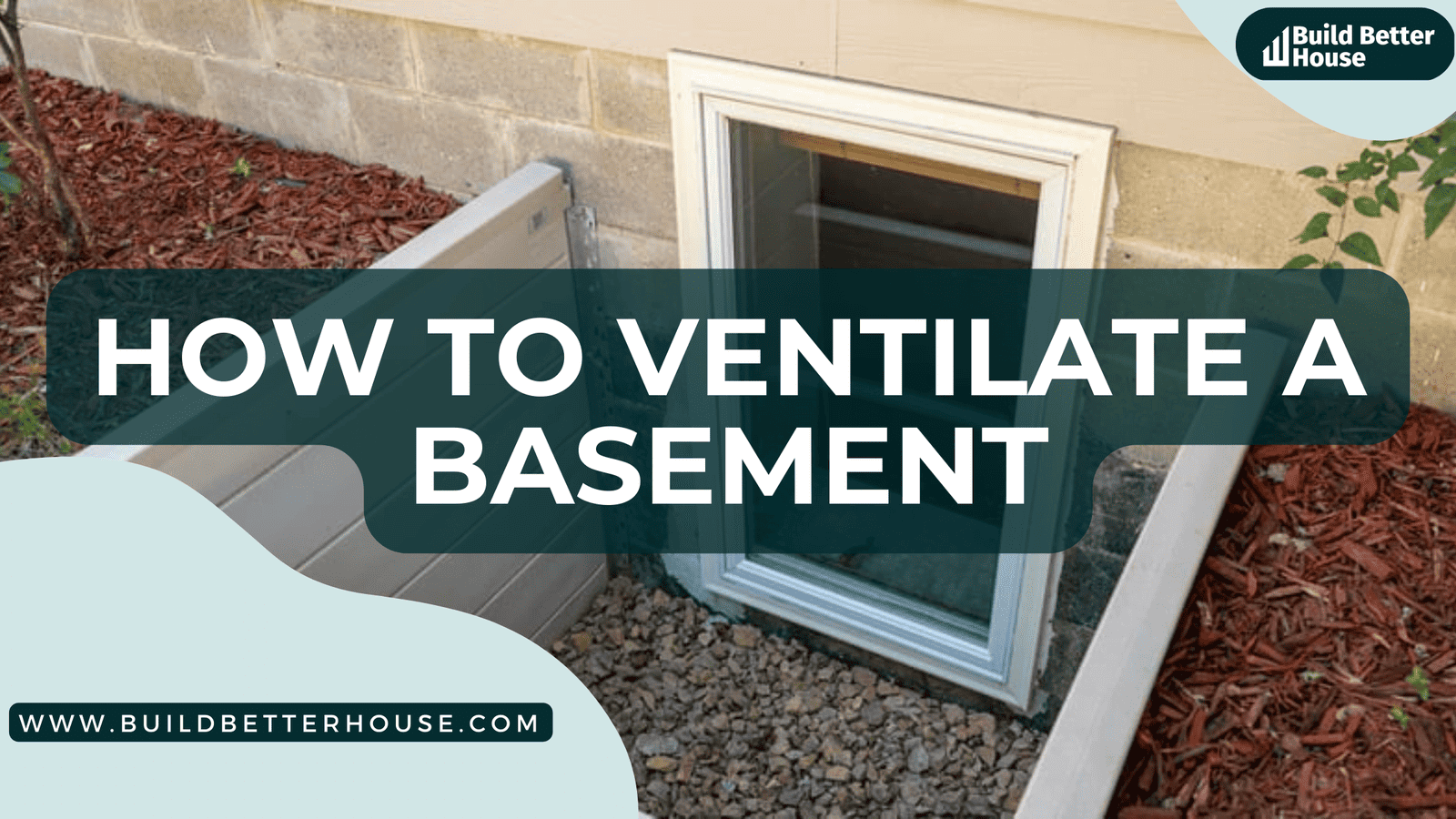How To Ventilate A Basement: 7 Effective Tips And Tricks

Are you wondering how to ventilate a basement? Ventilating your basement is crucial for maintaining a safe and healthy atmosphere, whether you use it as a workshop, a playroom, or storage. However, basement ventilation can be a challenge, as many factors exist.
Poor air quality in your basement will mean poor air quality in the rest of your home and can occur if the space is smelly, musty, or worse, plagued with moisture, mildew, or radon.
So, to help you sort things out, we’ve created this post to discuss how to ventilate a basement and some easy DIYs you can perform.
Understand the need for basement ventilation
When it comes to basements, the air can become stagnant and even contain dangerous toxins, making it essential to ventilate. The air can become stale, moist, and moldy without proper ventilation, leading to health issues. The lack of air circulation can also cause various other problems, such as condensation, which can lead to water damage and the spread of mold.
For these reasons, it is important to know how to ventilate a basement properly. Natural ventilation helps to bring in the fresh air, while mechanical ventilation helps to circulate the air in the basement. It is vital to note that ventilation is only adequate if the air can escape, so it is important to ensure that the basement has adequate airflow.
Since the ground floor is a natural access point, it features open and regularly close doors, allowing for additional ventilation. Upper floors may also have HVAC systems that circulate air in and out of rooms.
Basements are more airtight with poured concrete or masonry block walls. However, windows in basements are typically smaller and fewer in number. Upper-floor doors are not opened and closed as frequently.
Radon is an invisible radioactive gas with no odor and has also been linked to lung cancer in nonsmokers. According to the EPA, radon is the second most significant cause of lung cancer in the general population.
Along with radon problems, there is always the risk of black mold growing due to a poorly ventilated basement that accumulates moisture. Although not all basement mold is dangerous, mold is a crucial contributor to a musty smell in a basement.
How to ventilate a basement: Passive ventilation system
How to ventilate a basement have multiple methods you can address, one of which is Passive basement ventilation techniques, which don’t rely on any device. Passive ventilation systems are a fantastic approach to your question about how to ventilate a basement efficiently and affordably before adopting artificial ventilation techniques.
Open Windows
The quick and handy solution on how to ventilate a basement- open your windows and allow fresh air to enter. Leave windows open as much as you can when the weather permits. Remove the window well cover if it is there to allow air to travel through the window since ground-level windows can send leaves and other debris into the basement and install screens and window wells.
Note:
It’s very beneficial to open two windows simultaneously at opposing ends of the basement to encourage a cross breeze.
Installing or extending windows
Add windows to your basement or increase the size of existing ones. Windows can be installed in the wood wall framing system in shallow basements. Deeper basements necessitate cutting into the brick foundation, a complex project that requires a professional’s expertise.
Open the doors
Well, the next easy method in the list of how to ventilate a basement is- Keep all room doors in the basement as open as possible. Keep the door to the stairwell leading down to the basement. This allows you to benefit from the air passing through at-grade open windows and screened doors.
Note: Passive ventilation strategies will only help in the short run if your basement has radon issues. According to EPA research, radon concentrations return to normal within 12 hours after windows and doors are closed.
4. Keep It dry and clean
When you look for how to ventilate a basement, you must also consider the cleanliness of your place because a dirty area allows for unpleasant odors, and a clean basement is always welcome, regardless of the window. Keep the basement nice and tidy by packing unused items into boxes. That way, there will be less obstruction and turbulence on the airflow path.
Use a dehumidifier to regulate the basement humidity level. You can also add indoor air-purifying plants in the basement to liven up the space. Lastly, scented candles add a pleasing aroma and boost airflow circulation.
Since cleaning and making your area dry and humid-free will undoubtedly benefit you and your home, we have listed a few other tactics you can easily follow and answer your query about how to ventilate a basement!
How to ventilate a basement: Artificial ventilation system
Well, you can also respond to the question of ‘how to ventilate a basement’ with artificial or mechanical basement ventilation systems for ventilating a basement that uses a device (usually electrically powered) to flow air in and out of the basement.
Exhaust Fans
If your basement bathroom has an exhaust fan, use it during a shower or bath and leave it on until all moisture is gone. Replace low-capacity bathroom exhaust fans with higher-capacity fans. This is also one of the less expensive and effective ways on the list how to ventilate a basement.
Portable air purifier
The simple and practical method for moving air through the basement without using windows. Install an air purifier such as NuvoMed in the basement and switch it on to enjoy filtered air for 30 minutes to 2 hours.
The air purifier will draw in stagnant air and filter out impurities such as dust, hair, mildew, pollen, germs, bacteria, smoking, and odor. Clean air will be returned to the atmosphere. The purification cycle will continue as long as the air purifier is turned on.
Anyone entering the basement will breathe clean, healthy air devoid of allergens. An air purifier is very inexpensive to operate and may provide all-day ventilation. It works well in a windowless basement where the air purifier can be left unattended for days or weeks.
The sole disadvantage of a portable air purifier is that the filter must be replaced regularly, or it will become clogged and unable to ventilate. Depending on the size and type, changing the filter might cost as little as $50 or as much as $500. The good news is that changing the filter is simple, and most filters only need to be replaced once a year.
Install an HRV to reduce radon
Consider installing an HRV or heat recovery ventilator if you have a radon problem. This equipment, also known as an air-to-air heat exchanger, allows outside air into the basement. The HRV heats the incoming outdoor air with ejected warm or cool air to stabilize the basement temperature.
HRVs successfully remove radon gas for all general basement ventilation requirements. If you feel you have radon in your basement, engage a trained radon contractor to test it for radon and apply mitigation measures.
These are all artificial methods that you may use to reduce musty odors and other issues like mold by just following one of them.
Last word
The humid conditions, combined with insufficient sunshine, produce ideal conditions for the growth of mold, mildew, and other diseases. When you walk into the basement and notice a distinct musty odor, it’s time to bring in some fresh air.
How to ventilate a basement; we’ve listed a few solutions above that you can consider and follow to avoid smells in your basement and other basement-related issues. Keep your entire home ventilated and clean thoroughly because it might also affect your health.
Read more:
6 Best Aquarium Sump Pumps: Which One Is Best For You?
3 Best Crawl Space Sump Pumps: Which One Is Best For You?
Complete Zoeller M267 Review: Is It Worth the Investment?
5 Best Home Improvement Stores Near You In 2023






